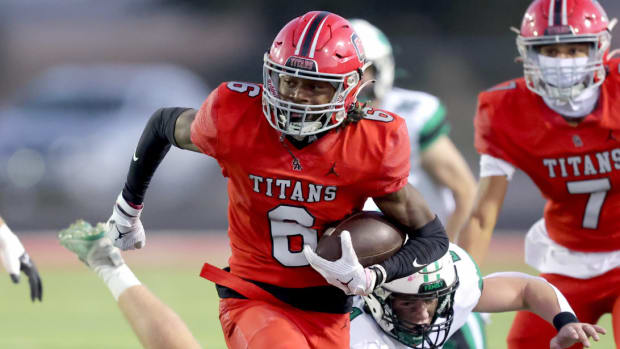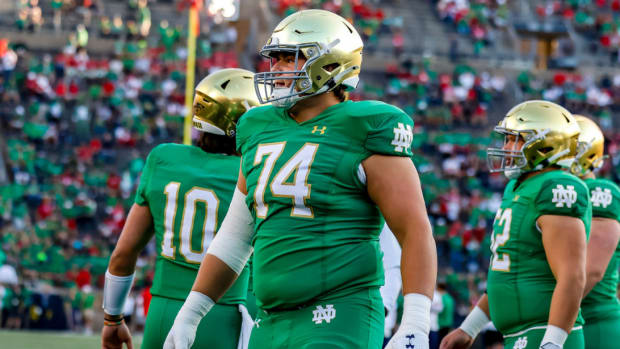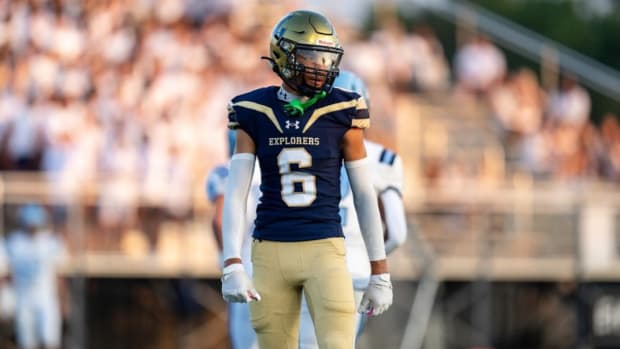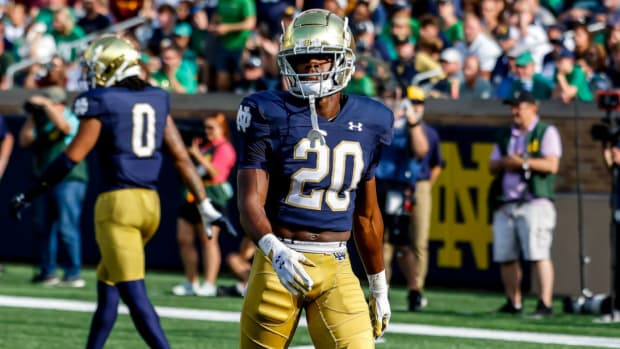Inside The Numbers: Notre Dame Defense vs. USC Offense
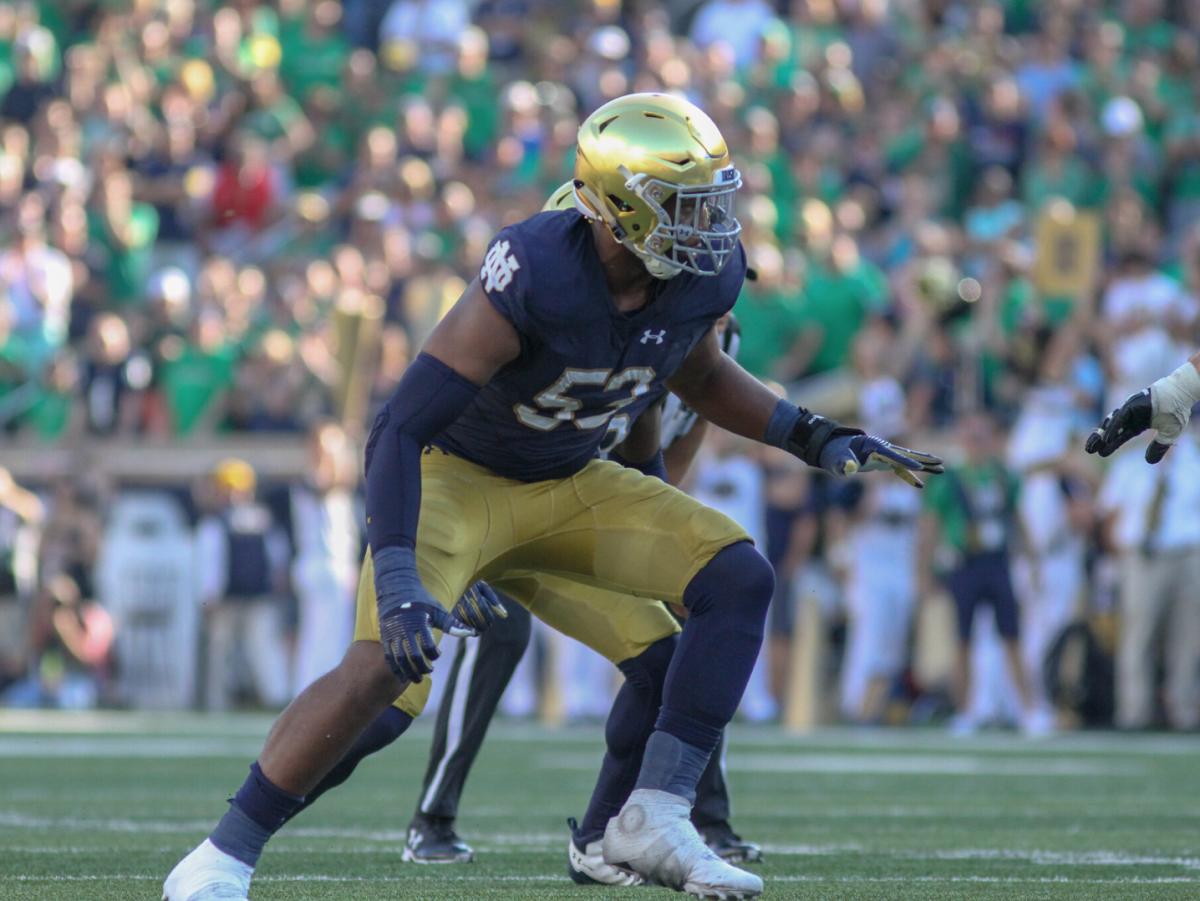
USC is in the midst of learning a new system, and the deeper the Trojans get into the Graham Harrell system the better they will run it.
Of course, much of the talk will rightly be focused on the elite talent USC has at wide receiver. That alone makes the Trojans dangerous, and matching up against that group will be a significant challenge for Notre Dame.
While the Trojan wideouts take up much of the conversation about this game, the Notre Dame defense has quietly been putting together another excellent season. In fact, in many areas the Irish are better statistically than they were during their undefeated run last season.
This game, however, will be the biggest test yet for defensive coordinator Clark Lea and his staff.
Let’s take a look at how the Notre Dame defense stacks up on paper against the USC offense.
Notre Dame Scoring Defense vs. USC Scoring Offense
Advantage: Notre Dame
Despite heavy personnel losses from its 2018 defense, the Irish have been outstanding on this side of the ball. There were some early season hiccups and there are still kinks to be worked out, but Notre Dame has thrived at keeping opponents off the scoreboard and off the field.
Notre Dame currently ranks 13th nationally in scoring defense and is down almost four points from last season. No opponent has topped 23 points in a game and no opponent has yet to get to 400 yards of offense. In fact, only one opponent - Louisville - has topped 380 yards against the Irish defense.
Notre Dame has allowed fewer points and fewer yards per game than it did a season ago, and it has equalled its yards per play average. That has occurred despite Notre Dame being less effective in the red zone.
The key for Notre Dame has been its ability to keep opponents out of the red zone altogether, which is a result of a much-improved third-down defense and a unit that currently ranks third in the nation in turnovers gained with 14. Right now the Irish defense is on pace for 34 turnovers gained in the regular season after forcing just 21 in all of 2018.
Notre Dame allowed opponents to move the chains at a 38.9-percent clip a season ago, but that number is down to 33.8-percent this season. It’s not a number that is inflated by beating up on inferior opponents either, as Notre Dame allowed Bowling Green to convert a season-high 42.1-percent of its third-downs.
The Irish defense held its three Power 5 opponents (Louisville, Georgia, Virginia) to 35-percent on third-down, and the two ranked opponents it faced (Georgia, Virginia) converted just 32-percent of their third-down opportunities.
USC’s pedestrian offensive numbers are misleading and due mainly to a revolving door at quarterback thanks to a season-ending injury to starter JT Daniels in the opener and a concussion sustained by freshman Kedon Slovis.
Slovis is expected to return and start against the Irish. In the two games that Slovis started and finished the Trojans averaged 36.0 points, 472.0 yards and 6.7 yards per play. That includes USC’s 30-23 victory over then 10th-ranked Utah in a game where the Trojans averaged 7.1 yards per play. In the three games he didn’t start or didn’t play the entire contest the offense went for just 25.0 points, 401.0 yards and 6.1 yards per play.
While he lacks the physical tools of Daniels, Slovis is a smart and savvy player for a true freshman, and he’s a good ball distributor. If he’s healthy the offense will be more dangerous than it was during its 28-14 loss to Washington, a game in which third-string quarterback Matt Fink was picked off three times.
Watching USC on film you see an offense that is incredibly streaky. At times the offense can’t seem to get much going, but once they get hot they can move the ball with ease, ripping off big gains and moving the chains. That’s when the Trojans are dangerous.
Notre Dame Rush Defense vs. USC Rush Offense
Advantage: Notre Dame
It wasn’t that long ago that many of the national pundits were saying the kryptonite for the Irish defense was its ability to play the run, or lack thereof. That was the primary point many used to say Notre Dame had no chance against Georgia, a team that was averaging almost 300 rushing yards per game when they squared off.
Watching Notre Dame give up 249 rush yards in the opener to Louisville and 212 to New Mexico in week three made those concerns understandable, but even while the Irish were giving up yards you could see the potential.
Notre Dame was more disruptive against the run than it had been the previous season, and most of its issues had to do with contain problems, assignment mistakes and mobile quarterbacks. It was all correctable.
Over the last three games the defense has cleaned up a lot of those mistakes, and the result has been an impressive stretch of play by the Irish defense.
In its last three games - which includes matchups against two opponents currently ranked in the Top 20 - Notre Dame has given up just 91.3 yards per game on the ground while allowing just 2.6 yards per carry.
If you take sacks out that number is at just 118 yards per game and 3.8 yards per attempt. Notre Dame currently ranks 11th in the nation with 46 tackles for loss and is on pace for 77 non-sack tackles for loss in the regular season. The Irish defense had just 78 tackles for loss - including sacks - in 13 games last season.
USC looked good running the ball in the opener against Fresno State and it racked up 212 yards on the ground in the loss to Washington. In between, however, the offense couldn’t get much going with its rushing attack.
Sacks excluded, USC averaged just 107.7 rushing yards per game and 3.5 yards per rush during a three-game stretch against Stanford, BYU and Utah. That included a 171-yard output against a BYU defense that currently ranks 119th in rushing defense, giving up 220.8 yards per game. No BYU opponent has rushed for fewer yards against it than did USC.
Notre Dame Pass Defense vs. USC Pass Offense
Advantage: USC
This is the one area where USC holds an advantage over Notre Dame.
The Fighting Irish actually hold the numbers advantage across the board, until you get to sacks. But context matters to truly understand how these two teams match up in this department.
Neither team has been tested much this season, with Notre Dame’s five opponents ranking between No. 48 (Georgia) and No. 113 (Bowling Green) in pass offense, while USC’s five opponents rank between No. 56 (BYU) and No. 110 (Stanford) in pass defense.
Notre Dame has had a steady pass defense all season, dominating inferior opponents the way you expect a top defense to do. The Irish rank second nationally with just three touchdown passes allowed, and it ranks 16th nationally with six interceptions. Notre Dame ranks 14th in interceptions per game.
All the numbers are strong, but there are two areas that are concerning about this matchup.
One is the success Georgia had throwing the ball while it overcame a 10-7 deficit and turned it into a 23-10 lead, and the success Virginia had in the first half, during which it shredded the Irish defense. UVa. quarterback Bryce Perkins completed 18-of-22 passes for 235 yards in the first two quarters before the Notre Dame pass rush could take over.
The second troubling area is the loss of starting cornerback Shaun Crawford, which moves nickel corner TaRiq Bracy into the starting lineup and leaves a void at the nickel spot. Junior linebacker Jeremiah Owusu-Koramoah filled that spot against Bowling Green, but USC presents a dramatically different set of problems for the slot defender.
USC has strong pass numbers, ranking in the Top 30 nationally in yards per game, yards per attempt and sacks allowed. But the Trojans were at their best when Slovis was in the starting lineup. In those three contests - one of which he was knocked out early - USC averaged 342 passing yards per game and and an impressive 10.4 yards per attempt.
That yards per attempt number would rank eighth nationally if extended over the entire season.
The Trojans have a long and fast group of receivers, and the unit gave the Irish fits early last season. Notre Dame goes into this game not only without All-American cornerback Julian Love - who now plays for the New York Giants - but also without Crawford, who was playing good football prior to his elbow injury against Virginia.
Notre Dame will have to tackle well, but being able to get after the quarterback could be the biggest key in this game.
Follow me on Twitter: @CoachD178
Visit our Facebook page at: https://www.facebook.com/IrishMaven/





